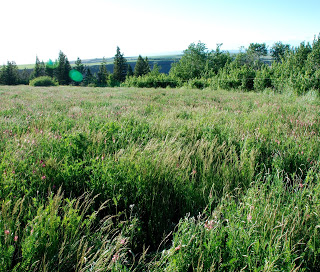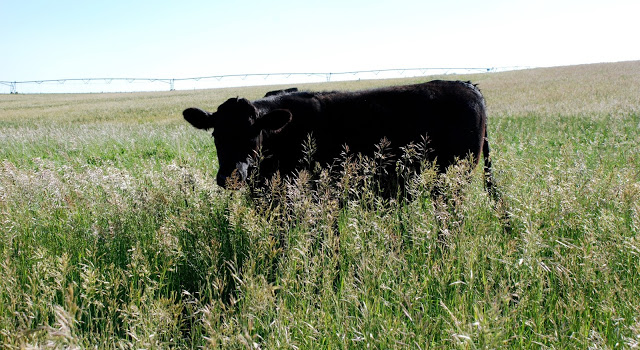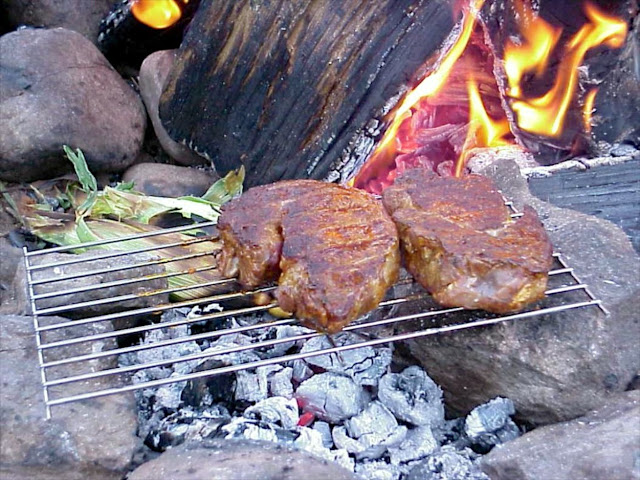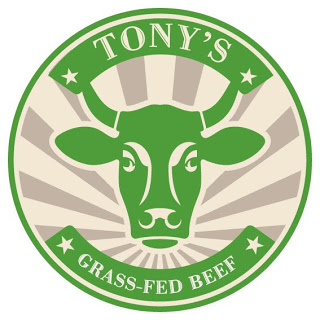We’ve been searching for great tasting 100% Grass Fed Beef product for over 5 years now. Why so long? We need something very special for our food savvy shoppers. Unfortunately most 100% Grass Fed beef available isn’t very impressive on the plate, and no matter how many requests we get, we just don’t want to offer products we’re not proud of. After all, it’s great tasting meats that originally put us on the map!
I am proud to say that the search is over and we’re confident we’ve found the finest tasting 100% Grass Fed Beef in the country! I’ve been to a lot of ranches, but never before have I seen one as unique and forward thinking as our new partners. Find grass fed beef in your local market!
Free Ranging on Irrigated Native Grasses
To develop marbling, cattle need all the rich and green grasses, forbs and legumes they can possibly eat, as well as convenient access to plenty of fresh water. Without it they spend way too much time searching for food and walking back and forth to water; which results in tough, dry and gamey tasting beef.
Meet The Rancher
I was lucky enough to spend a few hours with the ranch owner and pasture manager and made the short video below. I’ve been on a lot of ranches, even worked my uncle’s as a kid, but I’ve never seen pastures like these, or met ranchers who think like our partners at Teton Water’s Ranch.
It’s The Water
It’s no secret that raising great beef is all about having enough water. Enough to maintain high-nutrition forage throughout the growing season. Enough watering holes to avoid excessive cattle exercise. And enough water to grow plenty of alfalfa to supplement lower-nutrition winter pastures.
To get enough water, this forward thinking rancher converted 4,000 acres of prime irrigated row crop fields into carefully selected native grassland pasture, alfalfa and watering holes. Located on the banks of the Teton River and near its source, they have all the water they need!
Ranching WITH The Wild
These fields are also home for countless small mammals, songbirds, birds of prey, deer, elk, moose, foxes, coyotes and the occasional mountain lion. Committed to ranch WITH the wild, hundreds of acres are planted and maintained just for them. These non-irrigated fields near the river’s edge are planted in specific grass blends and shrubs that attract local and migrating wildlife while stopping erosion. Why? Because it’s the right thing to do!

Native grasses and aspens are maintained at the canyon rim, preventing erosion and benefiting native species.
- Prime irrigated non-GMO pastures
- Topsoil is improved, not eroded
- The land, grasses and animals work in harmony

A wide selection of shoulder deep green grasses offer greater nutrition, resulting in beef with better marbling, juiciness and taste. Note the watering pivot in the background, a rare sight in a cow pasture!
Great Cattle Treated Right
It all starts with the right cattle; select strains of Red and Black Angus adapted to thrive on native grasses at 6,000 feet. Raised strictly according to Organic practices, they are treated as well as any family pet. These cattle are never confined and will spend their entire life behaving naturally on prime open pastures; left alone to eat, drink and digest their food freely.

‘New Age’ Ranch Owner Jeff Russell
The use of mobile fences allows for natural pasture rotation; the ranchers simply string a new fence and the cattle walk onto a fresh pasture. In winter they’re moved to rented native pastures at lower altitudes where the weather is milder, and their grazing is supplemented with prime alfalfa from the ranch.
Our animals get the best life possible, and an easy, humane death in a Brush CO. facility approved by Temple Grandin (the foremost authority on humane cattle handling). Being harvested, cut and packed in Colorado, they carry the ‘Colorado Proud’ label.
- Select Red and Black Angus cattle
- Never fed grain or GMO’s
- Never confined, always on open pasture
- Never put in a feedlot
- No antibiotics, hormones or beta-agonists
- No harassment or cattle prods
- Mobile fencing for natural movement
- Moved to lower pastures in winter
- All Organic practices
- Humanely harvested in Colorado
Health Advantages
Eating only native grasses and getting more exercise gives this special beef some important health advantages.
- 2-4 times more Omega-3 Fatty Acids
- 3-5 times more Conjugated linoleic acids (CLA)
- Higher in antioxidants
- Lower in fat and calories
- Lower ratio of Omega-6 Fatty Acids

Eating only prime grasses gives this beef higher levels of Omega-3′ and CLA’s with less fat and calories
Taste Differences
Our 100% Grass Fed beef is different than our traditional Grass Fed Grain Finished beef. With less fat and more exercise 100% Grass Fed Beef has a slightly fuller taste with welcome mineral notes. Folks from farming families tell us, “It tastes like beef used to!” and bison, elk and deer meat lovers often prefer it to our milder and richer tasting Grass Fed Grain Finished Beef.

I suggest cooking Rare-plus to Medium-rare, cover and rest 10 minutes before slicing for the ultimate juiciness
We still offer our premium grade Grass Fed Grain Finished Beef. These cattle range freely on open pastures for most of their lives and then are fed a careful and varied blend of grain and silage from local row crops for three months before harvest. This assures the highest quality beef with the best marbling, juiciness and tenderness possible. I like to think of it this way; our 100% Grass Fed beef is the best-tasting beef Mother Nature can grow, while our Grass Fed Grain Finished Beef is the best-tasting beef possible.
Cooking Tips
100% Grass Fed Beef does cook a little differently, mainly because of its lower fat levels. Generally speaking, it cooks more quickly and is easier to overcook. I suggest NOT trimming off any fat and cooking more slowly with lower temperatures to protect the healthy fats within. For instance if you generally grill your steaks on medium high heat, opt for medium low to medium heat instead. Just like other meats, remove from the grill about 10 degrees below your ideal finish temperature, cover and rest for about 10 minutes before slicing. This keeps far more of the natural juices inside, rather than running all over the cutting board and plate.
If you like a nicely seared crust on your grilled meats, here is another great method… Preheat a two-temperature / indirect grill (medium-hot direct heat on one side, no direct heat on the other) and sear both sides quickly over the hot side, and then move to the indirect side, cover and adjust to finish cooking with air temperatures from about 200-300 degrees. By the way, these two methods are exactly how I recommend cooking Bison, Elk, Deer and other game meats.

Slower cooking and resting before slicing is highly recommended.

Our Promises
We don’t bend the rules, don’t beat around the bush and don’t have any fine print we hope you don’t read. These are our promises to you…
- 100% Grass Fed, no grain ever
- Never given hormones
- Never administered or fed antibiotics, antimicrobials or beta-agonists
- All Organic practices
- Never in a feedlot
- Humane treatment
Comments are closed.

